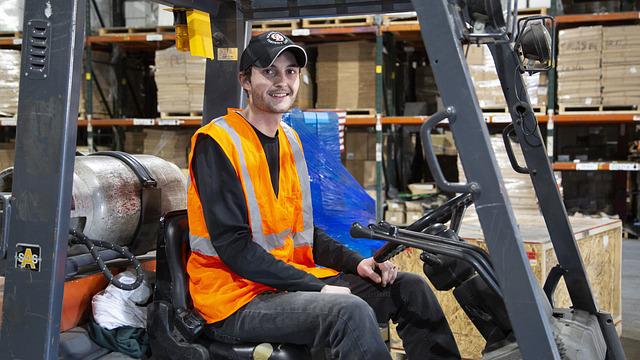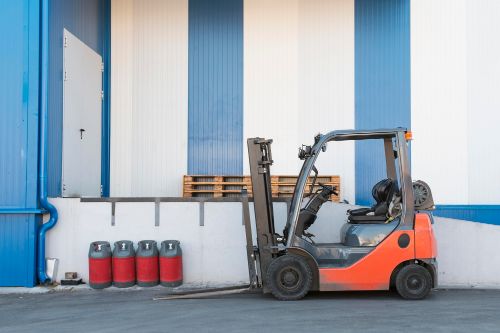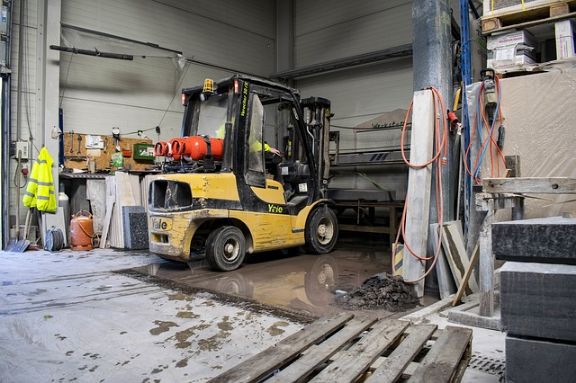
A forklift propane tank can explode if it is not properly maintained. When a propane tank is not properly maintained, the pressure inside the tank can build up and cause the tank to explode. A forklift propane tank explosion can be very dangerous and can cause serious injury or death.
Rust and corrosion can form over time and can make the metal weak causing leaks. This leak can start small making it impossible to detect. And with just a small spark, this leak can spark and cause the tank to explode.
Factors That Can Contribute To This Accident
When you’re working with forklifts that run on propane, understanding the factors that could lead to a tank explosion is crucial for your safety and that of your coworkers. Here’s a breakdown of what you need to keep an eye on:
A. Unique Chemical Properties of Propane That Present Risks
- Your Vigilance with Flammable Materials: Remember, propane is highly flammable. A small leak combined with a spark can lead to a big problem.
- Understanding Vapor Pressure: Propane expands when it warms up. If you notice a tank is too pressurized, it could be a sign of overfilling or a warm environment.
- Knowing the Limits: The lower explosive limit of propane tells you how little gas it takes to ignite. Make sure you understand these numbers.
B. Mechanical and Structural Vulnerabilities in Tanks
- Watch for Wear and Tear: Regularly inspect your propane tanks for signs of wear that can weaken the structure over time.
- Stay on Top of Corrosion: Check for rust and corrosion. These signs can indicate your tank might not be as sturdy as it looks.
- Check Seals and Valves: If you find a seal or valve that isn’t quite right, flag it. Leaks often start small and unnoticed.
- Be Mindful of Impacts: A collision or drop might not cause immediate issues, but it can damage the tank’s integrity over time.
C. Environmental Conditions That May Precipitate Tank Compromise
- Temperature Matters: Extreme heat or cold can wreak havoc on tank pressure. Always consider the temperature of your work environment.
- Keep Humidity in Check: Propane tanks don’t like too much moisture. Humidity can speed up corrosion.
- Be Aware of Pressure Changes: Sudden atmospheric pressure changes are rare but can strain your propane tank.
- Avoid Harmful Chemicals: Some industrial chemicals can damage your tank. If you work around these, extra caution is needed.
D. Operator Errors That Can Lead to Dangerous Situations
- Handle with Care: Moving tanks requires attention and care. Dropping or bumping them could cause unseen damage.
- Refuel Correctly: When refilling a propane tank, follow the protocols to avoid overfilling and rapid pressurization.
- Don’t Skip Leak Checks: Before and after using a forklift, take the time to check for leaks. This simple step could prevent a major incident.
- Stick to the Safety Plan: It might be tempting to cut corners, but your safety depends on following all the safety protocols every time.
By being aware of these factors and actively managing them, you play a critical role in keeping your workplace safe from the risk of propane tank explosions. Stay observant, stay informed, and never underestimate the importance of safety procedures.
The potential dangers of using a forklift propane tank
While it is true that a forklift propane tank can explode if it is damaged or not properly maintained, there are a number of potential dangers that can occur if one is not careful when using a forklift propane tank. First and foremost, it is important to remember that propane is a highly flammable gas.
If a forklift propane tank is leaking, it could easily catch fire and cause serious damage or even death. Additionally, forklifts that use propane tanks are often equipped with a regulator. If this regulator is not properly maintained, it could fail and allow too much propane to flow into the tank, causing it to explode.
It is always important to follow the manufacturer’s instructions when using a forklift propane tank. Improper use could easily result in an explosion.
Carbon monoxide can form during the use of the tank. Proper ventilation is needed when operating propane-powered forklifts.
Educating the Forklift Operators of this Danger
Educating forklift operators is a critical aspect of maintaining workplace safety, particularly when it comes to handling hazardous materials like propane. A robust training program should extend beyond routine operational protocols, focusing on the subtler, less obvious dangers that can lead to serious incidents. Here’s how you can structure such an education initiative:
A. Specialized Training Modules Focused on Recognizing and Responding to Less Apparent Dangers
- Customized Hazard Identification
- Develop training tailored specifically to you, the operator, teaching you to spot the subtle signs of propane tank wear or malfunction, such as minor corrosion spots or unusual odors that could indicate risk.
- Risk Assessment and Management
- Equip yourself with a systematic approach to identifying and evaluating risk factors that you might encounter daily, especially those not covered in general safety training.
- Advanced Operational Safety Procedures
- Engage with advanced modules that focus on best practices for maintaining tank integrity during both routine operations and peak demand times.
- Emergency Protocols for Uncommon Situations
- Learn detailed response strategies for scenarios that are not typically covered by standard emergency procedures.
- Incident Reporting Workshops
- Practice effective documentation and reporting of minor incidents or observations that could potentially escalate if unaddressed.
B. Simulation-Based Training for Emergency Response to Potential Explosion Scenarios
- Implementing Realistic Simulations
- Embrace the use of virtual reality (VR) and simulation technologies to create an immersive training experience that closely mimics real-life emergency situations involving propane tanks.
- Explosion Scenario Workshops
- Participate in interactive simulations that guide you through various stages of an emergency, teaching you to recognize the initial signs of a tank fault and respond appropriately.
- Use of Emergency Equipment
- Get hands-on training in the use of emergency response equipment within the context of a simulated explosion scenario to prepare yourself for real-life incidents.
- Post-Simulation Analysis
- After simulation exercises, take part in debriefing sessions that discuss the actions you took, your decision-making process, and identify areas for improvement.
- Continuous Training and Reevaluation
- Engage in periodic simulation training to keep your emergency response skills sharp and ensure that you remain up-to-date with any new safety protocols or equipment.
By investing time in specialized and simulation-based training, you can significantly improve your ability to identify and respond to non-obvious risks associated with forklift propane tanks, fostering a safer working environment and mitigating the risk of potential explosions.
How to safely use a forklift propane tank
A forklift propane tank can explode if it is not used properly. Here are some tips on how to safely use a forklift propane tank:
Training and Certification:
- Operator Certification: Ensure that anyone operating a forklift or handling propane tanks is properly trained and certified according to OSHA regulations and any local guidelines.
Pre-Use Inspection:
- Visual Checks: Before use, perform a visual inspection of the tank for any signs of damage, rust, or wear.
- Valve and Hose Inspection: Check that the valve is off before connecting and ensure the hose is in good condition without any cracks or wear.
Installation:
- Proper Installation: Follow the manufacturer’s instructions for tank installation. Secure the tank properly in its designated place on the forklift.
- Check for Leaks: After connecting, check for leaks using a soapy water solution or a suitable leak detector.
Operation:
- Start with Ventilation: Always start the forklift in a well-ventilated area to avoid the buildup of propane gas.
- Regular Monitoring: While the forklift is in operation, be alert for the smell of propane, which indicates a leak.
- Shut Down Procedure: Learn and follow the proper shut-down procedure for the forklift, ensuring that the propane tank’s valve is closed after use.
Refueling:
- Safe Refueling Area: Always refill or exchange tanks in a designated safe area that is well-ventilated, free of ignition sources, and specifically approved for propane refueling.
- No Smoking: Prohibit smoking and any open flames near the refueling area.
- Personal Protective Equipment (PPE): Use appropriate PPE, such as gloves and eye protection, when refueling to protect against propane exposure.
Maintenance:
- Routine Maintenance: Keep up with the forklift and propane tank’s maintenance schedule according to the manufacturer’s recommendations.
- Professional Inspections: Have the tank inspected by a professional periodically to ensure it’s in good working order.
Storage:
- Proper Storage: When not in use, store the propane tank in an upright position in a secure, well-ventilated area away from ignition sources.
Emergency Readiness:
- Know Emergency Procedures: Be familiar with emergency procedures in case of a propane leak or fire, including evacuation routes and emergency contact numbers.
- First Aid Training: Operators should have basic first aid training to address potential exposure to propane.
By adhering to these practices, you can ensure the safe handling and use of forklift propane tanks. Remember that the key to safety with propane tanks is vigilance, proper training, and regular maintenance.
What to do if a forklift propane tank explodes
If a forklift propane tank explodes, it is a serious emergency situation that requires immediate and decisive action to protect life and property. Here’s what to do:
- Evacuate Immediately: Ensure that you and everyone else evacuate the immediate area quickly and safely. Move to a safe distance away from the explosion site.
- Call Emergency Services: As soon as you are in a safe location, call 911 or your local emergency services number. Inform them that there has been an explosion and provide them with all the necessary details including the location, potential hazardous materials involved, and if there are any known casualties or ongoing dangers.
- Do Not Return to the Area: Even after the initial explosion, the area may not be safe. There could be risks of secondary explosions, fires, or toxic gas releases.
- Account for Personnel: Once you are in a safe area, account for all personnel who were in the vicinity to ensure everyone is safe. Do not attempt to rescue people by re-entering the dangerous area; leave this to the trained emergency responders.
- Provide First Aid: If you are trained in first aid and if it’s safe to do so, provide assistance to anyone who is injured until professional medical help arrives.
- Secure the Area: If it’s possible and safe, secure the area to prevent others from entering the hazardous zone until emergency services take over.
- Contain the Fire if Possible: If a small fire has started and you are trained in the use of fire extinguishers, you may attempt to extinguish it, but only if this can be done without risking your safety or the safety of others.
- Follow Emergency Responder Instructions: Once emergency services arrive, comply fully with their instructions. The emergency responders will take control of the scene and may have further instructions for your safety.
- Cooperate with Investigations: After the emergency is over, there will likely be an investigation. Provide any information you can to investigators to help them determine the cause of the explosion.
- Professional Debriefing: Participate in any debriefings or counseling sessions offered. Explosive incidents can be traumatic, and it’s important to address the psychological impact as well as the physical one.
- Review Safety Protocols: After the situation has been contained and investigated, review and update your company’s safety protocols to prevent future incidents.
Remember that propane tank explosions can be extremely dangerous and are best handled by professional emergency responders. Safety should always be the top priority.
How to tell if a forklift propane tank is leaking
Detecting a forklift propane tank leak is critical for maintaining a safe work environment. Here are some steps and signs that can help you determine if a propane tank is leaking:
1. Smell:
- Propane has a strong, unpleasant smell, often compared to rotten eggs or a skunk’s spray. Manufacturers add this odorant to alert you in case of a leak.
2. Listen:
- A hissing or whistling sound coming from the tank or the forklift’s fuel system can indicate that gas is escaping from a leak.
3. Look:
- Visually inspect the tank and connections for any signs of damage or wear that could cause a leak.
- Look for frost build-up on the tank, which can sometimes occur in the area of a leak due to the cooling effect of the escaping gas.
4. Soap Solution Test:
- Create a solution of soapy water and apply it to the connections and valves on the tank.
- Bubbles forming from the solution indicate where gas is escaping.
5. Use a Gas Detector:
- A handheld gas detector can be used to detect propane leaks. These devices are designed to alarm when propane is found at unsafe levels.
6. Check the Pressure Gauge:
- A dropping pressure gauge can indicate that propane is escaping from the tank.
7. Professional Inspection:
- If you suspect a leak but can’t confirm it, call a professional to inspect the tank with specialized equipment.
Safety Precautions:
- Do not attempt to locate a leak if you smell gas. Evacuate the area immediately and follow proper emergency procedures.
- Do not use open flames, electrical equipment, or any source of ignition if you suspect a leak.
- Always wear appropriate personal protective equipment when checking for leaks.
If you detect a leak or suspect that a tank is leaking, it is important to follow your company’s safety procedures immediately, which will likely involve evacuating the area, shutting off the gas supply if it can be done safely, and contacting the proper authorities or emergency response teams to address the leak.
What to do if you smell gas near a forklift propane tank
If you smell gas near a forklift propane tank, it’s a signal of a potential propane leak, which can be dangerous. Immediate action is required to ensure safety and prevent any possible hazards. Here’s what you should do:
- Evacuate the Area: Alert anyone in the immediate vicinity and evacuate the area. Avoid panicking; move to a safe location quickly and calmly.
- Extinguish Ignition Sources: Ensure that all ignition sources such as open flames, cigarettes, and electrical equipment are turned off. However, do not switch lights or equipment on or off if they are already in use, as this could create a spark.
- Avoid Cellular Phones Near the Leak: Do not use a cell phone or any other electronic device until you are at a safe distance from the suspected leak. Electronic devices can generate sparks that may ignite the gas.
- Shut Off the Gas Supply: If it’s safe to do so without risking ignition, shut off the valve on the propane tank to stop the flow of gas. Make sure you are familiar with the correct procedure for shutting off the valve.
- Ventilate: Again, if it can be done safely, open doors and windows to allow the gas to disperse, reducing the concentration of propane in the air.
- Report the Leak: Once you are at a safe distance, report the leak to the proper authorities or your facility’s emergency response team. If necessary, call the fire department or gas utility company for assistance.
- Do Not Re-enter the Area: Stay clear of the area until it has been declared safe by emergency personnel. Propane is heavier than air and can settle in low-lying areas, which can create invisible dangers.
- Check for Symptoms: If you or anyone else is experiencing symptoms of propane inhalation (such as dizziness, headache, nausea, or difficulty breathing), seek medical attention immediately.
- Leak Investigation: Do not attempt to find the source of the leak yourself. This should be left to professionals who have the proper equipment and training to handle hazardous situations.
- Follow-up: After the area has been deemed safe and the leak has been addressed, ensure a qualified technician inspects the forklift and the propane tank before putting it back into service. The cause of the leak should be identified and rectified.
- Review Safety Procedures: After the incident has been resolved, review safety procedures with all staff to ensure proper protocol is followed in the future. Use the incident as a learning opportunity to prevent similar occurrences.
Remember, safety is the priority. Propane leaks can escalate quickly, so prompt and appropriate actions are crucial.
How to store a forklift propane tank
Storing a forklift propane tank properly is vital for maintaining safety and extending the lifespan of the tank. Here are some guidelines on how to do this correctly:
- Choose an Appropriate Storage Area: Select a well-ventilated area for storing your propane tanks. An outdoor space is ideal, but if the tanks must be stored indoors, ensure the area is not prone to temperature extremes and has ample airflow.
- Maintain Upright Position: Always store propane tanks in an upright position to keep the pressure relief valve in proper working order. This helps prevent leaks and ensures the tank functions correctly.
- Secure the Tanks: Prevent tanks from tipping over by securing them with chains or in a proper holding rack. Stability is crucial to prevent damage to the tanks or valves.
- Keep Away from Ignition Sources: Store tanks away from any source of ignition, including sparks, open flames, or electrical equipment. A minimum distance of 20 feet is recommended.
- Temperature Regulation: Avoid storing tanks in areas where the temperature may exceed 120°F (49°C). Extreme heat can increase the pressure inside the tank, risking a breach or explosion.
- Protect from the Elements: If stored outside, protect the tanks from weather conditions like rain, snow, and direct sunlight, which can lead to rusting or excessive temperature changes.
- Limit Access: Store propane tanks in a secure area to limit access. Only trained personnel should handle or move these tanks.
- Signage and Labeling: Clearly label the storage area with the appropriate hazard signs. This includes ‘flammable gas’ warnings and ‘no smoking’ signs.
- Follow Legal Regulations: Adhere to any local, state, or federal regulations regarding the storage of propane tanks. This can include specific requirements for distance from other structures, capacity limits, and more.
- Regular Inspections: Even when not in use, periodically check stored tanks for leaks, corrosion, or other damage. Make this part of your regular safety inspections.
By following these storage tips, you can ensure that your forklift propane tanks are kept in a condition that minimizes risk and maximizes safety for you and your team.
How to refuel a forklift propane tank
Forklifts that use propane as a fuel source have a tank that needs to be refilled on a regular basis. When refueling, it’s important to take some basic safety precautions to avoid any potential accidents.
First, always make sure that the forklift is turned off and the engine is cool before starting to refuel. Then, locate the fill valve on the tank, which is usually located near the bottom. Once the fill valve is found, attach the hose from the propane tank to the fill valve and open the valve.
Fill the tank until the gauge reads full. Once the tank is full, detach the hose and close the valve. Make sure to tighten the valve to avoid any leaks. Finally, check the area around the forklift for any leaks. If there are any leaks, turn off the valve and contact a qualified technician to fix the problem.
Here’s What You Can Do to Prevent Explosion
Ensuring the safety of propane tanks on forklifts is essential for preventing hazardous incidents. Here are some key protocols and procedures that you should adhere to:
A. Regular Maintenance Schedules and Safety Checks
- Stick to a Schedule: It’s important to establish and follow a routine maintenance schedule for your propane tanks. Regular checks can catch issues before they become serious problems.
- Comprehensive Inspections: When performing safety checks, be thorough. Look for signs of wear, corrosion, or damage. This includes checking hoses, connections, and the tank itself.
- Documentation: Keep a log of all inspections and maintenance activities. This not only helps ensure that no checks are missed but also provides a record in case of an incident.
B. Proper Refueling Techniques to Prevent Accidents
- Know the Process: Refueling a propane tank is a procedure that you should carry out with precision. Make sure you understand the steps involved.
- Avoid Overfilling: Tanks should never be filled to 100% capacity as propane expands with temperature changes. Most tanks have an overfill prevention device, but you should still be cautious.
- Secure Environment: Ensure the refueling area is free from open flames, sparks, and is well-ventilated.
C. Protocols for Handling and Storage of Propane Tanks
- Correct Handling: Always transport propane tanks using the correct methods and equipment to avoid dropping or jarring the tanks.
- Storage Guidelines: Store propane tanks in a well-ventilated area, away from high traffic and potential impact threats. They should also be stored upright and secured to prevent falling.
- Temperature Control: Keep tanks out of extreme temperatures. Storage areas should be dry to prevent rust and corrosion.
By following these safety protocols and procedures, you actively contribute to a safer working environment. It’s your responsibility to be informed about these practices and to implement them consistently.
To Make a Finalization
A forklift propane tank can explode if it is not properly maintained or if it is damaged. A propane tank explosion can cause serious damage to property and injuries to people. A propane tank explosion can also cause a fire.
Make sure the tank is in good working condition before installing it on the forklift. Recertification of the tank can be done regularly to make sure that the tank can still be used in the next few years. A qualified technician is the one who can do the recertification not just anyone else.

Mike is an experienced propane technician with over 15 years of professional experience in the field. He has dedicated his career to helping customers with their propane needs, from installation to maintenance and repair. Together with Jeremy, he co-founded this website to provide useful information and guidance to customers seeking reliable propane services.




